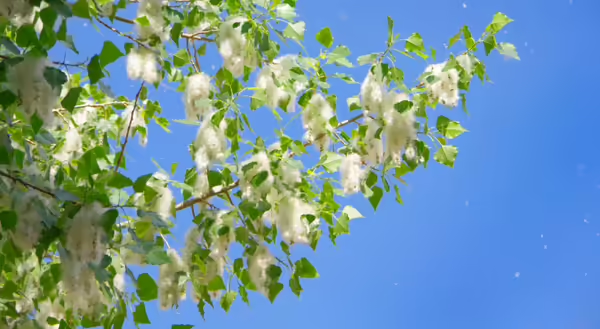
A recent family trip westward to Yellowstone and Grand Teton National Parks offered a chance to observe the changing landscapes of the Midwest. While Iowa’s familiar fields of corn and soybeans resemble much of Illinois, the transformation across Nebraska—from tallgrass to shortgrass prairie—reveals a striking ecological gradient. One of the most visible and ecologically important features along Interstate 80 is the Platte River and its floodplain, dominated by the eastern cottonwood. Of course, this species is found throughout Illinois so, after a little road trip inspiration, let’s consider the eastern cottonwood.
The mighty cottonwood (Populus deltoides)
The eastern cottonwood (Populus deltoides) is a fast-growing, deciduous tree native to a vast range of the Eastern United States. Its range extends from southwest Manitoba to the Gulf Coast of Texas, and from western Kansas to the Atlantic Ocean, including southern states such as Louisiana, Mississippi, Alabama, Georgia, South Carolina, and North Carolina. It is absent from the higher elevations of the Appalachian Mountains and much of New England.
In this vast range, cottonwoods tolerate a wide range of conditions: temperatures from -50°F to 115°F, annual precipitation from less than 15 inches to over 55 inches, and frost-free periods ranging from under 100 to over 200 days.
Cottonwoods thrive in lowland areas such as the floodplains and riverbanks. They prefer well-drained soils and tolerate intermittent flooding. Their presence helps stabilize streambanks, reduce erosion, and provide habitat for diverse wildlife.
These fast-growing trees can reach towering heights of over 100 feet and create a distinctly recognizable vase-shaped canopy. The bark is grey and deeply furrowed. The leaves grow to two to five inches in size and are broad and flat. Leaves are alternately arranged on the stem. The leaf petioles are three to four inches long and are flat, which allows the leaves to flutter in the wind. Leaves turn yellow in the autumn.
Cottonwoods are dioecious, meaning they produce male and female reproductive structures that are wind-pollinated. Flowering occurs in early spring. Male catkins form in clusters at the tips of branches, while female flower catkins are singularly produced. Following pollination, female flowers develop into hanging clusters of dehiscent fruit that, when dry, split open to release the seed. Seeds have lightweight fibers that resemble cotton (Gossypium spp.) to aid wind dispersal.
Right tree, right place
While cottonwoods offer valuable ecosystem services, they must be planted with care. Their wood is weak and prone to breakage, and their shallow roots can interfere with underground infrastructure. Additionally, seed dispersal may be undesirable in urban settings.
Cottonwoods are best suited for large open areas such as parks, riparian corridors, and conservation lands. Though not always a favorite, they contribute to forest diversity and resilience. With thoughtful site selection, Populus deltoides can be a hardworking and appreciated part of our landscape—especially when summer brings its signature “cotton snow.”
Good Growing Fact of the Week: The western range of the native Populus deltoides is not well defined as a result of distribution overlap with plains cottonwood (Populus deltoides var. occidentalis).
Thank you for reading!
Sign up for our emails! Want to get notified when new Good Growing posts are available? SIGN ME UP
Give us feedback! How helpful was this information (click one): Very helpful | Somewhat helpful | Not very helpful
MEET THE AUTHOR
Emily Swihart is a horticulture educator with University of Illinois Extension, serving Henry, Mercer, Rock Island, and Stark counties since 2021. Emily provides horticulture programming with an emphasis on the home gardener, the urban forest, native plant ecosystems, and landscape design. Additional responsibilities include supporting local county Master Gardener and Master Naturalist volunteers - providing training, continuing education, advanced training, and their involvement in seasonal events and community outreach programs.